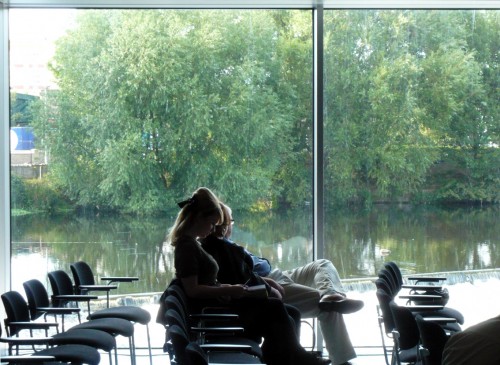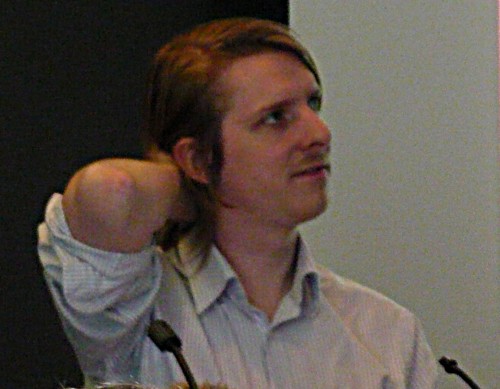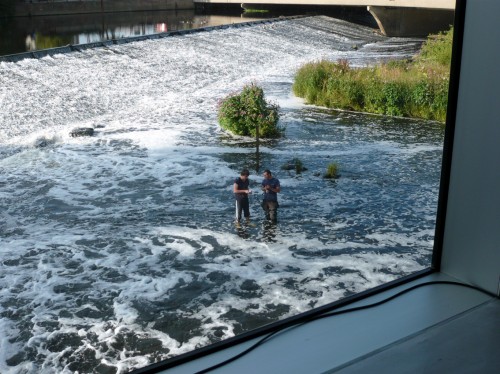
Guest blogger, Ivor Tymchak, visits the Hepworth Gallery in Wakefield to listen to one of their regular artists’ talks.
From the profusion of notepads being flourished in the audience, it would seem that a lot of the attendees were bloggers doing their bit for culture. Having been co-opted by Phil Kirby to attend, I considered myself in good company.
I sat next to the huge picture window that overlooked the weir in the River Calder and observed two fishermen standing in the shallow water. Their antics were an amusing distraction as I waited for the first speaker.
BERND BEHR was commissioned by the Hepworth to project a film onto the side of the building just before it opened. He had done his homework; years before the gallery was built, he visited the site. I looked at his pictures of trash floating in the unkempt river then looked through the window at the idyllic scene below in a comic double-take and realised how seductive redevelopment is.
In a clumsy wandering drawl he talked about crystalline structures, which were his inspiration for the brief. After spending a good fifteen minutes describing the books and the rationale for pursuing the crystal theme, he then declared that it turned out to be a dead end, and so talked about the stone from Hope Valley quarry in the Peak District — the main ingredient for the Hepworth concrete.
After he’d finished, I realized I had no idea what he was supposed to be talking about . . .
Owen Hatherley kicked of with a picture of dark satanic modernism. Ah, right, modernism in architecture. Got it. Unfortunately, his subsequent pictures took me on a nostalgia trip: I was educated in a Huddersfield school designed by John Poulson and I had student accommodation in the Hyde Park flats in Sheffield.
Although he talked about modernism, I couldn’t work out if he liked it or not.

As I tried to figure out what the connection between his talk and Behr’s was, I looked at the river out of the corner of my eye and the flowing water gave me the illusion that I was on a boat sailing down the river. This made me realise why the Hepworth was so successful as a building: the juxtaposition of the brutal slabs of concrete in a subtle shade of Payne’s grey with the white water of the river and bright green trees sets off the other perfectly. Had the building been located in the centre of Bradford, for example, it wouldn’t have worked.
A discussion followed the talks. This felt like the audience — predominantly white and middle class — were desperately looking for a point to them being there. Alas, largely due to politeness, none could be found and when the official proceedings were done, most people left immediately.
I’ve written before about the huge responsibility of curating the content of the Hepworth. The twenty or so people in the audience did their bit by turning up (and even paid £7 for the privilege). It’s up to the Hepworth now to fulfill its part of the bargain.
I left the event feeling somewhat short changed (and I hadn’t even paid). At least I saw the two fishermen catch several big fish.

How cool is that! Whenever I watch fishermen, they never catch anything.
This was over a one and a half hour period remember. They caught at least two big fish, photographed them then let them go.